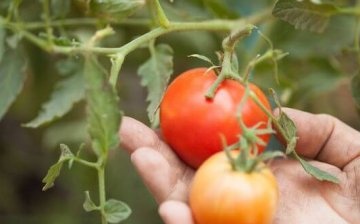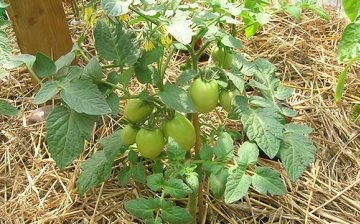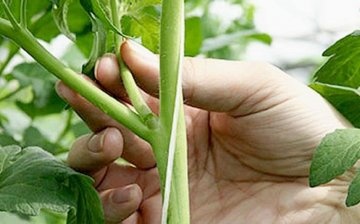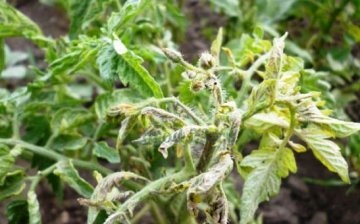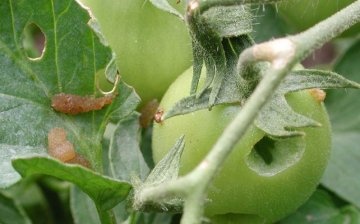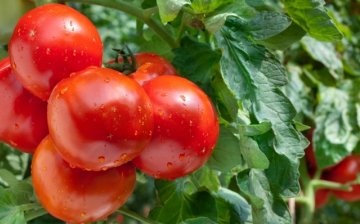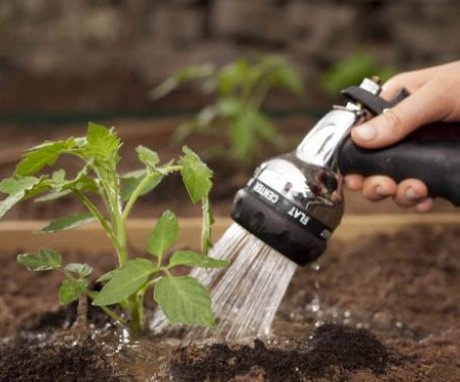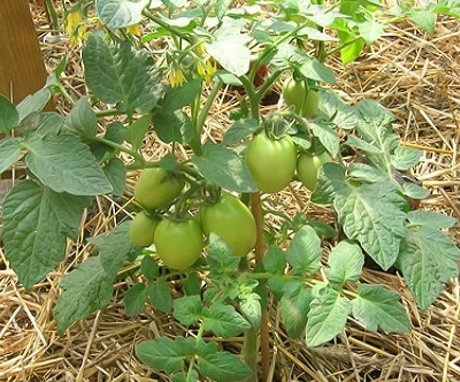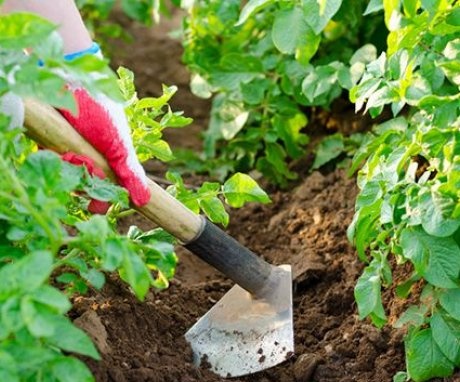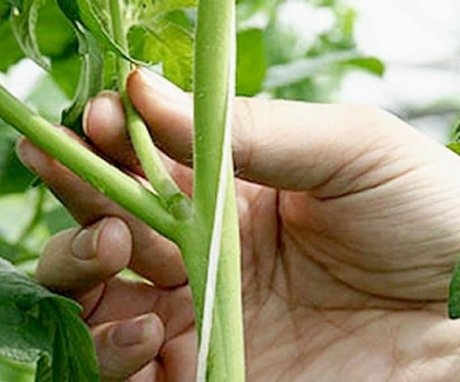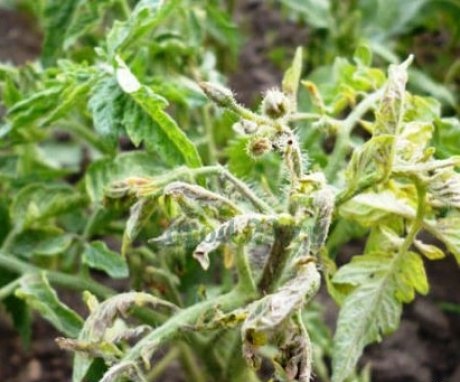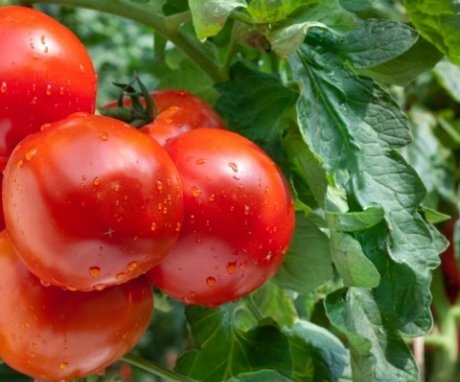Proper care of tomatoes outdoors
Grow a delicious red-sided appetizing a tomato every gardener dreams, both an experienced specialist and a beginner. But if an avid gardener already knows how to make a dream come true by resorting to certain planting care, then a novice amateur needs to know when to properly loosen, form seedlings, the timing of feeding and periods for full watering. The main feature of good, fast and productive growth of tomatoes is careful planting.
Content:
- Watering and feeding
- Mulching
- Loosening and hilling
- Bush formation
- Diseases - control and prevention
- Pests - control and prevention
- Best precursors for tomato
Watering and feeding
After the plant has been placed in the ground, the first thing to do is to spill it well with warm water. Moisture is the main food for tomatoes, but this is not a reason for overfilling the soil. Tomatoes do not tolerate swampy substrates, so irrigation should be moderate, as the earthy coma dries, but not dries out. Otherwise, excess moisture causes fungal diseases.
It is advisable to water the tomatoes using standing water in the room. Until flowering, the bushes are moistened 1 time in 7-8 days with a volume of water up to 1 liter. In drier areas, this figure decreases to 4-5 days.
Irrigation must be carried out during the period when the sun has already set.
When watering, make sure that water does not fall on the delicate leaves. Otherwise, the sun that has not yet sat down can cause burns to young greenery through water droplets. Watering carried out so as to shed all layers of the earth completely, moistening the soil around the root system.
To get a rich harvest, watering alone is not enough; fertilizers should be applied. The minimum care is feeding with nitroammophos once a season. For better growth and fruiting, it is advisable to feed the plant once every 2 weeks. When entering fertilizers, you must follow the rules:
- Organic additives (nitrogen) are used in small amounts. With excessive fertilizing, the plant stops bearing fruit and grows.
- If at the place of disembarkation before the time of planting the tomatoes were cucumbers or cabbage, then fertilizing is not worth it.
- For varieties of late fruiting, fertilizers are prepared during the preparation of the soil in the autumn.
- First feeding mineral fertilizers applied in 14-21 days after disembarkation in open ground.
- Overdose is dangerous for shrubs. There is a decrease in immunity, the duration of maturation increases.
During the period of growth of shrubs for the entire period, two additional fertilizing with mineral and organic fertilizers - at the beginning of June and in the middle of summer (in July). It is during this period that tomatoes most need a nutrient medium for the growth and formation of fruits. The input of useful elements and minerals must be carefully monitored, since their shortage, as well as an overabundance, entails poor growth and development of the plant. Ultimately, there is no harvest and plant death.
Mulching
Mulching carried out at the time of landing.Covering the ground is done with different materials, such as:
- Chopped straw, cut grass.
- Fallen autumn foliage.
- Wood sawdust or chips, tree bark.
- Compost.
- Newsprint.
- Inorganic shelter methods (purchased products).
There are many options, each gardener chooses the method as he wishes. Thanks to mulch, the following processes take place:
- The ground remains wet for a long period - there is no need for daily watering.
- The substrate retains nutrients in its structure.
- Prevents weeds from growing.
- Promotes the retention of the soil in its place - does not allow it to wash out from under the running water from under the roots.
Of the most revered options for mulching, straw is distinguished. It is not laid out immediately after mowing, but allowed to dry out for a while under the hot rays of the sun (2-3 days). After that, it is placed under the plant so that the ground next to the trunk completely covers, and falls 15 cm in height.After a few days, the grass will sag and a good layer of mulch of 5-6 cm is formed.
Thus, by covering the soil, a longer period of soil moisture is achieved, as well as saturation of the soil with the nutrient properties contained in the mulch.
Loosening and hilling
The soil is loosened as the top layer of the earth hardens. Such a crust prevents water from passing to a depth, allows the soil to be saturated only by 2-3 cm. Loosening not only has a fruitful effect on the flow of life-giving moisture to the root system, but also saturates the roots with the necessary oxygen.
Most often, such a crust forms after frequent heavy watering and with heavy summer rain.
In addition to loosening under the tomatoes, hilling of the earth is periodically carried out next to the trunk of the plant. The procedure is necessary for additional root formation and digging along the way weeds... Otherwise, parasitic plants will entwine all the soil and simply clog the cultivated plant.
Loosening and hilling alternate with each other. Each of the events must be carried out 3 times per season, then the plant will respond with lush growth and an abundance of red-cheeked tomatoes.
Bush formation
To obtain an abundant amount of fruit, a bush is formed. For this purpose, they constitute from 1 stem on large-stem (high) varieties and up to 3 main sprouts on low-growing types of tomatoes.
The circumcision period occurs during the active growing season, as well as as needed.
There are varieties that do not give stepchildren at all; you need to cut off the top in order to get additional branches. Others, on the contrary, throw out shoots at each branch. Stepsons grow in the axils of the leaves. When they reach a size of 5-7 cm, it is advisable to remove them. Otherwise, they do not allow the formation of fruits, thereby taking away all the nutrients for their own growth.
The grown sprouts are carefully removed with a sharp knife or broken off, leaving a stump of no more than 2 cm. Such a need so that the plant does not re-start new growth in this bosom. In the case of a cold, rainy season, tomatoes not only stepchildren, but also cut out the lower greens and excess shoots. This is done so that the plant warms up and ventilates better, allowing the fruits to fill and ripen in time.
Diseases - control and prevention
Any culture is susceptible to disease attack, especially one as delicate as tomatoes. There are several diseases that tomatoes are exposed to:
- Late blight - manifests itself with an increase in humidity up to 75% (while the optimal environment is 65%), it is also possible to develop on cool days when the temperature drops to + 15 + 20 C. Often the cause of the disease is abundant morning dew, which appears more often by mid-June ... Fruit rotting occurs on the plant. Infected vegetables are removed so that the disease does not spread to neighboring tomato clusters.The fight against the disease is carried out by irrigation with biological and chemical substances.
- White spot - dark spots appear on the lower tops of the bush. They completely affect the entire leaf, which subsequently falls off. The bush becomes infected at low temperatures and night drops up to + 15 + 17 C. The disease cannot be cured, it remains in the genetic predisposition of the plant. However, many modern varieties are immune to it.
- Alternaria - dark spots appear on the tops, then the leaf completely blackens and falls off. This process takes place at elevated air temperatures and high humidity. The process is oppressed by the frequent change of weather conditions. The fight is carried out using the chemical "Metaxilin".
Thus, you should periodically review your plantings for the presence of diseases that can affect not only one shrub, but also lead to the death of the entire garden.
Pests - control and prevention
In addition to diseases, tomatoes can be attacked insect pests... The harm from such parasites is no less than from diseases. The most frequent guests on tomato greens are distinguished:
- Medvedka - an insect up to 0.5 cm in length, found in moist soils located near water bodies. The fight against it is carried out with the help of an insecticide "Thunder" or under the influence of hot pepper infusion.
- The Colorado potato beetle is a striped beetle up to 1 cm, migrates with the adjacent potato leaves. It lays fatty larvae that love to feast on the delicate foliage of tomatoes. Plants should be irrigated with chemicals - "Phosvecid";
- The larvae of click beetles are yellow caterpillars, up to 0.2 cm in length, plump. They tend to infect the roots and the inner middle of the stem. The fight against them is carried out under the influence of "Bazudin".
If you control the process of plant growth, you can notice the appearance of harmful insects. In this case, they must be removed from the sheets until the moment of their reproduction and increase in number.
Best precursors for tomato
Tomatoes are a strong vegetable crop that actively absorbs minerals from the soil. In order for the harvest to be of high quality and not painful, it is recommended to change the planting site every year.
When choosing a new site, one should be guided by the knowledge of what was planted on this land in previous periods:
- Tomatoes grow and bear fruit well in the beds where legumes grew (beans, peas), root crops (beet, carrot, onion), different greens (basil, celery) bird cherry. They saturate the earth not only with nutrients, but also with oxygen.
- It is not recommended to plant red-sided fruits on the soil from under eggplant, pepper, zucchini or fennel. They tend to infect the soil with late blight, which successfully migrates to new seedlings.
Thus, caring for a tomato does not require much effort and control. But periodic loosening and viewing of seedlings for the presence of diseases and pests is still necessary.
More information can be found in the video:



